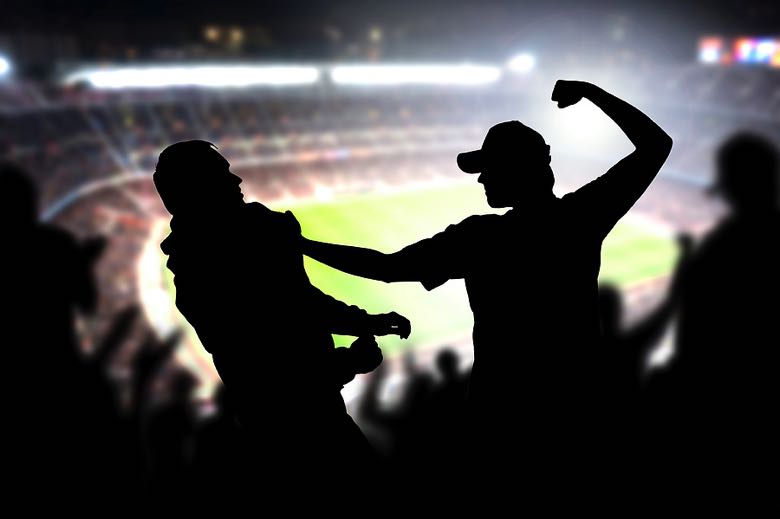Some football fans just love the ritual of a Saturday afternoon: planning their route to the ground (perhaps with a pre-game drink or two), cheering on their beloved, enjoying a nice warming pie at half-time before heading home – win or lose, they’ll be back next week.
But others take their support to a higher, rather more fanatical level. From pyro and tifo choreography to elaborate banners and chants, this hardcore community of supporters is the lifeblood of a football club – almost like a battleground horn-player serenading troops into war. This group has also been given a general, catch-all name too: ultras.
What Is the Difference Between Fans & Ultras?
As mentioned, the typical football fan engages with their club in a way that ranges from being a mild supporter – attending the odd game, perhaps buying a replica shirt – to fanatical: the season ticket holding individuals who won’t miss a game home or away, and often find themselves thinking about their beloved’s travails on any given day.
The ultra is like that obsessive fanatic – just with all the dials turned up to eleven. Not content with a half-time cup of Bovril or singing when they’re winning, this group of supporters creates and instigates chants, designs pre-game and half-time tifo displays (more on them later), unfurls banners and may even bring musical instruments to a match; be it drums, horns or anything else (although maracas rarely cut it).
The ultra is the most visual, most audible, most passionate of all football fans – although sometimes their fanaticism can lead to a darker shade of support. The use of pyrotechnics and smoke bombs, despite being banned from English stadia, has become something of a scourge in modern football, while there are clear links between some terrace ultras groups and hooliganism.
What Does Tifo in Football Mean?
One of the more positive elements of ultra fandom is the tifo – a glorious, technicolour celebration of a football club or one of its players, past or present. It takes its name from the Italian word ‘tifosi’, and is a visual and/or audiological display that is choreographed by the instigators. Generally revolving around a flag, banner or sign, tifo displays have started to integrate movement, lights and sound for the fully immersive experience.
Generally an expression of love for a football club, sometimes tifo can be more spiteful in nature – particularly when two rivals meets – or political; it’s not uncommon on mainland Europe in particular for the lines between football and politics to merge.
Dating back to Italy and other Mediterranean nations in the 1960s, tifo displays have since spread around the globe – it’s not uncommon to see such a choreographed performance in the Premier League on any given weekend. Tifo has since been most warmly embraced in America’s Major League Soccer, where crowd-funding appeals raise thousands of dollars to be spent on such displays.
Are Ultras Football Hooligans?

Football hooligans generally have one sole objective: to threaten, or enact, violence on the supporters of opposition clubs. Ultras, for the most part, don’t have that ambition: although controversial tifo displays, offensive chants and aggressive gestures on the terraces can at times lead to trouble.
Many ultras pride themselves on creating an intimidatory atmosphere too – you may have heard of home stadiums being described as ‘tough places to go’, and that’s in part down to the affect that an ultras group can have; Millwall, although less so these days at their new ground, often had an edge when playing at their old, daunting home at The Den.
As a general rule, ultras aren’t football hooligans – although there’s no doubt that the lines have blurred together at times over the years. Whereas a hooligan will typically travel in plain clothes as part of the ‘casuals’ culture, ultras are generally happy to wear their club’s colours with pride; that helps them to be more easily identified by police when travelling to games or spending time in towns and cities, which in turn lessens the risk of disorder.
Most ultras groups are typically only interested in supporting their team – even if in doing so, such as Turkish club Galatasaray’s ‘Welcome to Hell’ sloganeering, they are able to create an atmosphere that is unsettling and intimidatory to opposition players and fans.
What Are the Biggest Ultras Groups in Football?
Given that many of the earliest ultras groups were formed in Italy, it’s no surprise to learn that many passionate ultras still exist in the country to this day – a nation that, historically, has seen battles waged between the haves and the have nots, and those in the north against the south.
From the much-maligned south of the country, Napoli have one of the loudest and most rebellious ultras groups, but they often pale in comparison to the neo-Nazi linked ultras supporting Lazio and Roma. As well as explosive pyro and ear-piercing chants, their display often lead to violence inside and outside of the stadium.
From the city clubs of London to the tempestuous rivalry between Boca Juniors and River Plate in Argentina, it’s unfortunate that some ultras have become synonymous with violence – River Plate’s Los Borrachos del Tablon group is one of the most overtly terrifying in football.
Peaceful ultras groups rarely make the headlines, although those with the most prominent displays and ingenious choreographing at least give these small communities a good name. Borussia Dortmund’s ‘Yellow Wall’ is one such example, while FC Porto and Barcelona have also produced some of the most legendary displays over the years.
But few can compete with FC Copenhagen’s near performance art ahead of their game with Brondby back in 2014, which featured a cannon firing a cannonball and ‘destroying’ the stadium – an ingenious example of how to take a little and make a lot. And, it’s that side, rather than the darker element, that you hope football ultras will become renowned for.

